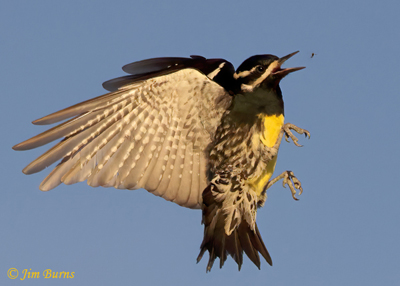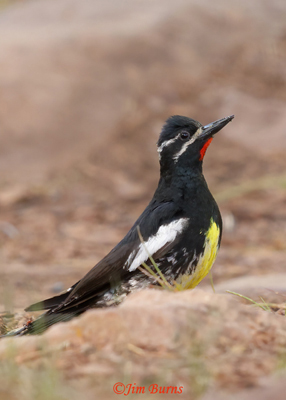Willy Sap

A case could be made for Willy Sap being North America’s most beautiful woodpecker and it’s most unique. Male plumage is stunning eye candy with its white rump, wing patches, and facial stripes contrasted against black, the yellow belly, and the red chin and throat. But this is also our only woodpecker that is sexually dimorphic. The female’s plumage is so different, plain brown head, cryptic dark and light barring on the body, that early naturalists thought male and female were two distinct species.
Willy Saps are the most conifer dependent of our four sapsuckers, breeding almost exclusively in Ponderosa Pine forests where they favor Quaking Aspen, usually but not always dead, for actual nesting. Males excavate the nest cavity, and pairs will often return to the same tree, if not the same hole, in successive years. Pairs only produce one brood per year, and adults and young disperse quickly, within a month after hatching.
Somewhat like our flickers, Willy Saps are ant specialists, but they are omnivorous and display a relatively high seasonal food specialization—conifer sap, phloem, and various fruits and berries in winter and pre-nesting, primarily ants after the young are born, though they will also glean beetles and other insects from the bark when feeding hatchlings. More than once I’ve seen females coming to a nest cavity with a bill full of color having found red, black, and brown ant varieties on the same foraging trip.
It has been suggested that both drumming cadence and drill pattern can be used to identify woodpeckers to species. While the first is certainly true, I could find nothing in the literature to corroborate the second other than the simple fact that all four species of sapsuckers drill neat hole patterns, whereas other woodpeckers drill quite randomly. The drill patterns I’ve seen Willy Saps working remind me of a cribbage board placed between two horizontal rows, one above and one below.
Willy Saps are, in general, a quiet, retiring species, even amongst the sapsucker tribe, with few loud calls and subdued drumming. The few calls I’ve heard, various “Churrs” and “Chyas,” are reminiscent to me of Clark’s Nutcrackers, but much lower and softer, and thus less frequently heard or noted above other forest sounds. This species does not use calls for mate attraction, but only for contact. Compared to the drumming of other sapsuckers their initial burst of beats is faster, but the volume and frequency quickly decreases as do the volume and frequency of subsequent rolls in the drum.
Over the course of our Scottsdale visitor’s sojourn I went to see him several times at all hours of the day. Several behavioral patterns began to emerge. Though Willy Sap had a favorite tree, the Aleppo Pine in which he was first discovered, he often “went missing” and I learned to just wait by his original tree rather than chasing him or searching the entire park, because he always came back. The reason is that except during nesting season, sapsuckers like hummingbirds, feed along a “trapline,” checking various wells on an established route. Sap and the insects it attracts, like hummers’ nectar and pollen, become replenished while the “hunter” makes his rounds to other sites on the circuit.
Our park Willy Sap seemed unbothered by all the runners and skateboarders, but dogs and their handlers under his tree always spooked him. But he still always came back . . . until he didn’t. It took me a few visits to realize he always disappeared from his trapline at the same time every afternoon, late but before sundown, and he always left for good from the same tree wells.
I began checking my watch as I anticipated the time of his last sap feeding, and finally one afternoon saw him depart the lower area of the park and fly uphill to a grassy knoll with several scattered Date Palm trees. Here at the open, sunny high point of the surrounding neighborhood where flying insects apparently swarmed in the warmth of the day’s last light I found our opportunistic sapsucker sallying forth from the palm fronds to take bugs out of the air as adeptly as any kingbird or empidonax!
Three species of woodpecker are known and well documented flycatchers (Lewis’s, Acorn, and Red-headed), but Willy Sap is not one of them, and the literature says they take flying insects “only infrequently.” I should not have been surprised, though, as we know all birds are nothing if not opportunistic feeders. His flycatching forays began every afternoon like clockwork and lasted until sunset, so predictable that I began just going to the park at 4:45 and sitting on the knoll to wait for him. Over the several weeks of my observations he never disappointed
I’m hopeful of course that one of these winters will bring us a Red-headed that lingers awhile, but until then Willy Sap has become my favorite woodpecker. His plumage is spectacular, their natural history is unique, and their preferred breeding habitat is where every Phoenician wishes they could be during the dog days of summer. Because of the remoteness of that habitat the species remains only poorly studied, and because of climate change with its inherent fires and insect infestations, it may be a prime indicator species for that habitat. Long may they prosper.
Willy Sap male, ant on tail

Willy Sap female, ants for nestlings